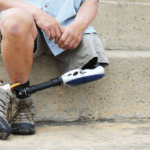Will my Knee Brace cause weakness or muscular atrophy?
By Ryan Cochrane on May 25, 2020 in Uncategorized

The simple answer? Yes…and no!! This question, my friends, is a difficult one to answer. However, I hear it a lot when seeing patients with knee problems. The reason it is a difficult question is that it really depends on multiple factors including:
- Style of Brace
- Reason for Wearing Brace
- Activities
- Patient age
I will try to explain different scenarios that may or may not cause muscle atrophy and will touch on one scenario where, I believe, knee bracing will actually increase strength and cause muscular hypertrophy.
Knee Brace Style
The style of a brace is the largest determining factor in causing your muscles to become weak. Simply put if the brace is restricting any part of your range of motion then you are going to get weak in that range. If you have ever seen a Zimmer Splint, which holds your knee in full extension, then you can imagine what I am talking about. If you have ever had to wear one, you can almost watch your muscles melt away.
On the flip side of this, a knee sleeve that provides compression and warmth to the knee, generally will not limit any range of motion and are not likely to cause any atrophy at all.
The most controversial brace style, when talking about muscle atrophy, is the functional knee brace. The functional knee brace is designed to protect injured ligaments. These may be prescribed pre or post-surgery. The trouble with these braces is that they need to stay in place in order to work properly. This means they are generally snug-fitting and that the top calf strap must be done up quite tight. Although, these measures prevent the knee brace from sliding down your leg, consequently, they also can prevent you from achieving full knee flexion. So, if we are limiting the range of motion then we are going to be causing a certain amount of muscle atrophy and weakness. Depending on the reason for wearing the brace, this may be a side-effect we are willing to accept.
Reason for Knee Brace Use
There are 5 main reasons you may wear a knee brace.
- Ligament Injury
- Patellofemoral Injury or Dysfunction
- Meniscus Injury
- Osteoarthritis (OA)
- Prophylactic Use
Generally speaking, braces used prophylactically or due to meniscus injury are sleeve style braces that provide warmth and compression. These style of braces normally allow full range of motion, therefore will not cause muscle atrophy or weakness.
Braces used for ligament injury, patellofemoral injury, and OA span a large range of styles depending on the severity of the injury. Patellofemoral bracing ranges from simple straps that change the angle of pull of the patella tendon, to sleeves with a lateral buttress to maintain patella (knee cap) tracking, all the way to hinged knee braces that may incorporate a lateral buttress or a web design. Braces for ligament injury and OA can also range from simple sleeves to custom hinged knee braces depending on the severity.
When it comes to OA, I believe, that knee bracing can actually increase muscular strength. In practice, I have seen patients who are in a terrible pain cycle and it goes like this. Their knee starts hurting so they stop exercising. Next, they gain weight due to their exercise routine being gone. With their increased weight, their knee starts hurting more. And round and round we go. The unfortunate thing for people is that every pound of bodyweight we gain it equals 4 times as much weight on the knee. The nice thing is that knee bracing can break this pain cycle. I have had patients who, after receiving their knee brace, have been able to start exercising again and they begin shedding the weight. This scenario is always one of the most rewarding things to witness!!
ActivitieS
The activities you perform in daily life is another factor to consider when choosing a knee brace. If you are working at a desk job and not exercising the brace you need will be different from someone who works construction and plays basketball every evening. Even if these two people have the exact same knee issue or injury. Generally, the rule is that the riskier the activity, the more support or protection you require to protect the knee following an injury.
Patient Age
Finally, as with activity, patient age can be a factor in determining what style of knee brace we will provide. Younger individuals will tend to heal faster than those that are older, so they don’t require as much support for the same knee injury. Also, as we get older we tend to lose hand strength so ensuring the brace is easy to apply is another important factor in this population.
As you can see, there are extremely wide ranges of options available for knee bracing. Hence, we always recommend a consult with a physician and/or physiotherapist who specializes in joint injuries. Luckily, here in southern Alberta those who injure their knee can access the Southern Alberta Acute Knee Injury Clinic and be assessed by a qualified team that will help determine what your needs may be. Of course, there is always the option of seeing one of our Certified Orthotists for a no-charge initial assessment.







Recent Comments